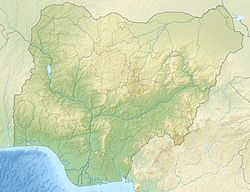
Back Osun-Osogbo AST Osun-Oshogbo AVK Osun-Osoqbo Azerbaijani Osun-Osogbo Catalan Osun-Osogbo Danish Heiliger Hain der Göttin Osun German Bosque sagrado de Osun-Osogbo Spanish Osun-Osogbo Finnish Osun-Oshogbo French Osun-Osogbo Hausa
| UNESCO World Heritage Site | |
|---|---|
 First Palace In Osun-Osogbo Sacred Groove | |
| Location | Osogbo, Nigeria |
| Reference | 1118 |
| Inscription | 2005 (29th Session) |
| Area | 75 ha (190 acres) |
| Buffer zone | 47 ha (120 acres) |
| Coordinates | 7°45′20″N 4°33′08″E / 7.75556°N 4.55222°E |

Osun-Osogbo is a sacred grove along the banks of the Osun river just outside the city of Osogbo, Osun State of Nigeria.
The Osun-Osogbo Grove is several centuries old[1] and is among the last of the sacred forests that once adjoined the edges of most Yoruba cities before extensive urbanization. In recognition of its global significance and cultural value, the Sacred Grove was inscribed as a UNESCO World Heritage Site in 2005.[2]
The 1950s witnessed the desecration of the Osun-Osogbo Grove: shrines were neglected and priests abandoned the grove as customary responsibilities and sanctions weakened. Prohibited actions like fishing, hunting and falling of trees in the Grove was done indiscriminately until an Austrian national named Susanne Wenger (1915-2009)[3] helped to reinstate traditional protections.[4]
With the support and encouragement of the Ataoja (the royal king of the time) and the support of the concerned local people. Wenger "formed the New Sacred Art movement to challenge land speculators, repel poachers, protect shrines and begin the long process of bringing the sacred place back to life by establishing it again, as the sacred heart of Osogbo".[5] Wenger later came to be honoured the titled "Adunni Olorisha" for her custodial efforts and her consistent devotion to the gods of the grove.
- ^ "Osun-Osogbo Sacred Grove".
- ^ Peter Probst. Osogbo and the Art of Heritage. Monuments. Deities, and Money. Bloomington: Indiana University Press, 2011.
- ^ "Susanne Wenger, a decade after the glow". The Guardian Nigeria News - Nigeria and World News. 2019-09-15. Retrieved 2022-06-03.
- ^ Peter Probst. "Modernism against Modernity. A Tribute to Susanne Wenger." Critical Interventions, Journal of African Art History and Visual Culture, 2009, No.3/4, 245-255. Peter Probst. "From Iconoclasm to Heritage. The Osogbo Art Movement and the Dynamics of Modernism in Nigeria." A Companion to Modern African Art. Edited by Gitti Salami and Monica Blackmun Visona (eds.) Malden, MA: Wiley-Blackwell, 2013, pp. 294-310.
- ^ "Osun Osogbo: Carnival of culture in a sacred forest". The Punch - Nigeria's Most Widely Read Newspaper. Archived from the original on 3 June 2015. Retrieved 18 August 2015.
© MMXXIII Rich X Search. We shall prevail. All rights reserved. Rich X Search
